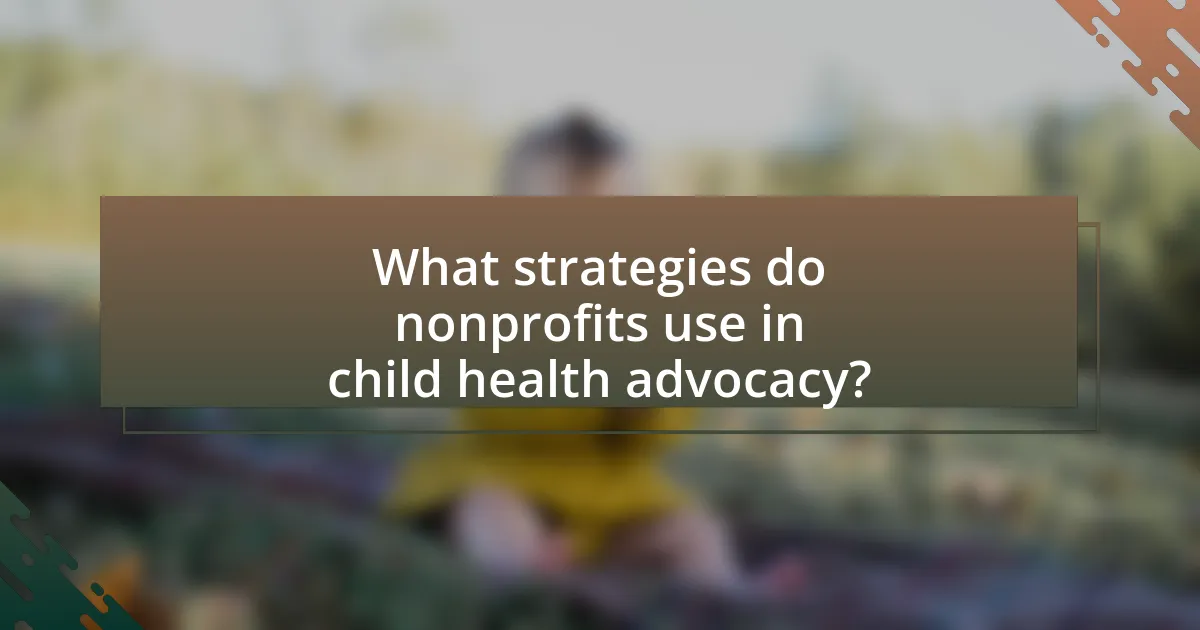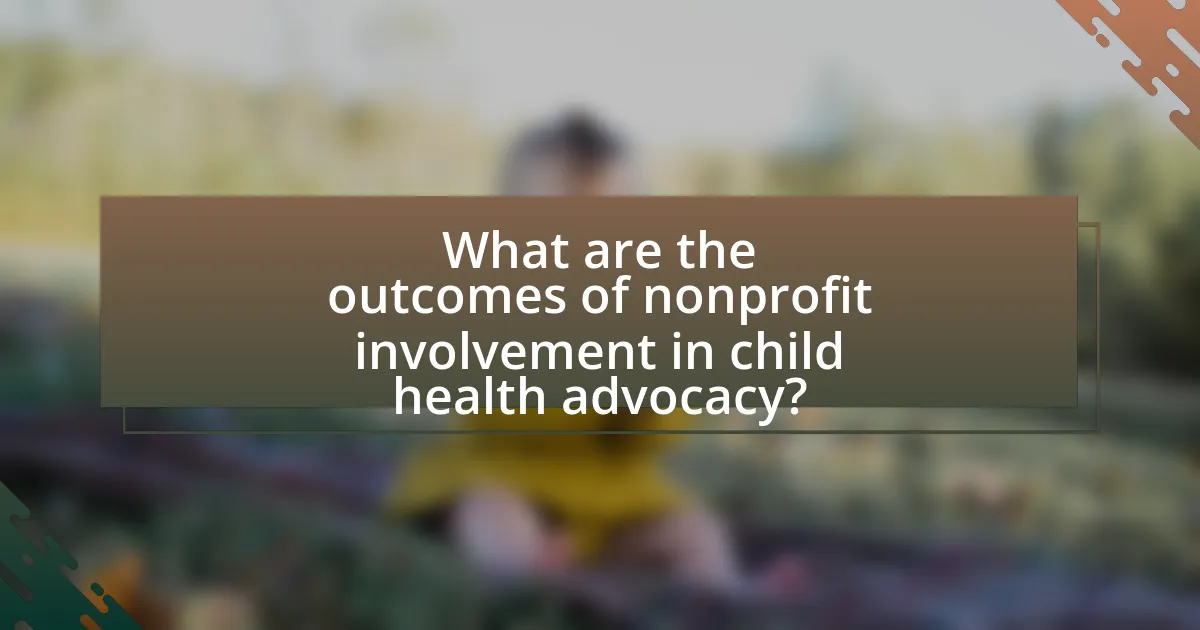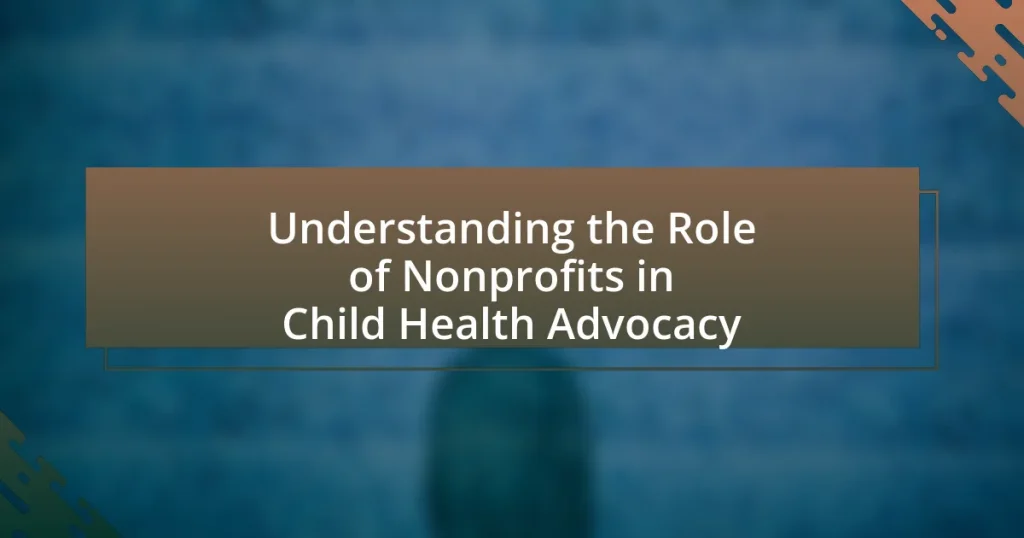Nonprofits play a vital role in child health advocacy by promoting policies and programs that enhance children’s health outcomes. They engage in research, raise awareness, and mobilize communities to address health disparities, while also providing direct services such as immunization and health education. Key organizations, like the American Academy of Pediatrics, influence legislation and implement initiatives that improve access to healthcare, nutrition, and mental health support for children. The article explores the strategies nonprofits use, the challenges they face in securing funding, and the measurable outcomes of their advocacy efforts, highlighting the significant impact of these organizations on child health and overall community well-being.

What is the Role of Nonprofits in Child Health Advocacy?
Nonprofits play a crucial role in child health advocacy by promoting policies and programs that improve children’s health outcomes. They engage in research, raise awareness, and mobilize communities to address health disparities affecting children. For instance, organizations like the American Academy of Pediatrics advocate for legislation that supports children’s access to healthcare services, demonstrating the impact of nonprofit efforts on public policy. Additionally, nonprofits often provide direct services, such as immunization programs and health education, which are essential for preventing disease and promoting overall well-being among children.
How do nonprofits contribute to child health advocacy?
Nonprofits contribute to child health advocacy by raising awareness, providing resources, and influencing policy changes that benefit children’s health. These organizations often conduct research and disseminate information about health issues affecting children, such as malnutrition and access to healthcare. For instance, the American Academy of Pediatrics, a nonprofit, advocates for children’s health policies and provides guidelines that shape healthcare practices. Additionally, nonprofits mobilize communities and engage in grassroots campaigns to promote health initiatives, such as vaccination drives, which have been shown to increase immunization rates among children. Through these efforts, nonprofits play a crucial role in improving child health outcomes and ensuring that children’s health needs are prioritized in public policy.
What specific programs do nonprofits implement for child health?
Nonprofits implement various specific programs for child health, including immunization initiatives, nutrition education, and mental health support services. For instance, organizations like the American Academy of Pediatrics run programs that promote vaccination to prevent diseases, while Feeding America focuses on addressing food insecurity among children to improve their nutritional health. Additionally, mental health programs, such as those offered by the National Alliance on Mental Illness, provide resources and support for children’s emotional well-being. These programs are crucial as they directly contribute to reducing child morbidity and mortality rates, enhancing overall child health outcomes.
How do nonprofits collaborate with other organizations in child health advocacy?
Nonprofits collaborate with other organizations in child health advocacy through partnerships, coalitions, and joint initiatives aimed at improving child health outcomes. These collaborations often involve sharing resources, expertise, and data to address common goals, such as reducing childhood obesity or increasing access to healthcare services. For example, the Alliance for a Healthier Generation, which includes nonprofits, schools, and businesses, works together to promote healthy environments for children, demonstrating the effectiveness of collective action in achieving significant health improvements.
Why is child health advocacy important?
Child health advocacy is important because it directly influences policies and practices that ensure the well-being of children. Effective advocacy leads to improved access to healthcare services, better nutrition, and enhanced educational opportunities, which are critical for healthy development. For instance, according to the World Health Organization, investing in child health can yield a return of up to $18 for every dollar spent, highlighting the economic and social benefits of prioritizing children’s health. This advocacy also addresses health disparities, ensuring that vulnerable populations receive the necessary support and resources to thrive.
What are the current challenges in child health that advocacy addresses?
Current challenges in child health that advocacy addresses include access to healthcare, nutrition, mental health, and the impact of social determinants of health. Advocacy efforts focus on reducing disparities in healthcare access, as approximately 5.4 million children in the U.S. lack health insurance, which limits their access to necessary medical services. Additionally, childhood obesity rates have risen, with 19.7% of children aged 2-19 classified as obese, highlighting the need for improved nutrition and physical activity initiatives. Mental health issues are also prevalent, with 1 in 6 children aged 2-8 years experiencing a diagnosed mental, behavioral, or developmental disorder. Advocacy aims to address these challenges by promoting policies that ensure equitable access to healthcare, improve nutritional standards, and enhance mental health resources for children.
How does child health advocacy impact overall community health?
Child health advocacy significantly enhances overall community health by promoting policies and programs that ensure access to healthcare, nutrition, and education for children. When children receive proper healthcare and support, they are more likely to grow into healthy adults, which reduces the prevalence of chronic diseases and healthcare costs in the community. For instance, initiatives led by nonprofits have been shown to improve vaccination rates and reduce childhood obesity, leading to healthier populations. According to the Centers for Disease Control and Prevention, communities with strong child health advocacy efforts report lower rates of preventable diseases and improved mental health outcomes, demonstrating the direct correlation between child health advocacy and community health.

What strategies do nonprofits use in child health advocacy?
Nonprofits use various strategies in child health advocacy, including public awareness campaigns, policy advocacy, and community engagement. Public awareness campaigns aim to educate the public and stakeholders about child health issues, often utilizing social media and traditional media to reach a wider audience. Policy advocacy involves lobbying for legislative changes that improve child health services and access, supported by data and research that highlight the needs of children. Community engagement focuses on mobilizing local resources and stakeholders to address specific health challenges faced by children, fostering partnerships with schools, healthcare providers, and families. These strategies are effective as they leverage collective action and informed advocacy to drive systemic change in child health.
How do nonprofits raise awareness about child health issues?
Nonprofits raise awareness about child health issues through targeted campaigns, community engagement, and educational programs. These organizations often utilize social media platforms, public events, and partnerships with schools and healthcare providers to disseminate information about critical health topics affecting children, such as nutrition, vaccinations, and mental health. For instance, the American Academy of Pediatrics conducts initiatives that educate parents and caregivers on child health, reaching millions through their resources and outreach efforts. Additionally, nonprofits often leverage data and research to highlight the importance of child health, such as the CDC’s statistics on childhood obesity, which inform their advocacy and awareness strategies.
What role does social media play in nonprofit advocacy efforts?
Social media serves as a crucial tool for nonprofit advocacy efforts by enhancing communication, mobilizing supporters, and raising awareness about specific issues. Nonprofits leverage platforms like Facebook, Twitter, and Instagram to disseminate information quickly, engage with their audience, and create a sense of community around their causes. For instance, a study by the Pew Research Center found that 69% of adults in the U.S. use social media, providing nonprofits with a vast audience to reach and influence. Additionally, social media campaigns can lead to increased donations and volunteer sign-ups, as evidenced by the success of initiatives like #GivingTuesday, which raised over $2.47 billion in 2021 alone. This demonstrates that social media not only amplifies the voice of nonprofits but also drives tangible support for their advocacy efforts.
How do nonprofits engage with policymakers to influence child health legislation?
Nonprofits engage with policymakers to influence child health legislation primarily through advocacy efforts, which include direct lobbying, grassroots mobilization, and coalition building. These organizations often conduct research to provide evidence-based recommendations, thereby equipping policymakers with data that highlights the importance of specific child health issues. For instance, the American Academy of Pediatrics has successfully influenced legislation by presenting studies that demonstrate the impact of childhood obesity on long-term health outcomes. Additionally, nonprofits frequently organize campaigns that raise public awareness and mobilize community support, which can pressure policymakers to prioritize child health in legislative agendas.
What funding sources support nonprofit child health advocacy?
Nonprofit child health advocacy is primarily supported by government grants, private foundations, corporate sponsorships, and individual donations. Government grants, such as those from the Health Resources and Services Administration, provide essential funding for programs aimed at improving child health outcomes. Private foundations, like the Robert Wood Johnson Foundation, also contribute significant resources to initiatives focused on child health advocacy. Corporate sponsorships from health-related companies can further bolster funding, while individual donations from community members and philanthropists play a crucial role in sustaining these organizations. Collectively, these funding sources enable nonprofits to effectively advocate for policies and programs that enhance child health and well-being.
How do grants and donations impact nonprofit operations in child health?
Grants and donations significantly enhance nonprofit operations in child health by providing essential funding for programs and services. These financial resources enable nonprofits to implement health initiatives, conduct research, and offer direct support to children and families in need. For instance, according to the National Council of Nonprofits, organizations that receive grants can expand their outreach efforts, improve healthcare access, and develop educational programs aimed at preventing childhood diseases. Additionally, donations often allow nonprofits to leverage matching funds or secure additional funding from other sources, amplifying their impact on child health outcomes.
What are the challenges nonprofits face in securing funding for child health initiatives?
Nonprofits face significant challenges in securing funding for child health initiatives, primarily due to competition for limited resources, fluctuating donor priorities, and the need for measurable outcomes. The competition for funding is intense, as numerous organizations vie for the same grants and donations, making it difficult for individual nonprofits to stand out. Additionally, donor priorities can shift based on current events or trends, which may lead to reduced funding for child health initiatives if they are not perceived as urgent. Furthermore, many funders require clear metrics and evidence of impact, which can be challenging for nonprofits to provide, especially when working with vulnerable populations where outcomes may take time to manifest. These factors collectively hinder the ability of nonprofits to secure consistent and adequate funding for their essential child health programs.

What are the outcomes of nonprofit involvement in child health advocacy?
Nonprofit involvement in child health advocacy leads to improved health outcomes for children, increased awareness of health issues, and enhanced policy changes. Nonprofits often mobilize resources and expertise to address specific health challenges, such as malnutrition or access to healthcare services, resulting in measurable improvements in child health indicators. For instance, organizations like Save the Children have reported significant reductions in child mortality rates in regions where they implement targeted health programs. Additionally, nonprofits advocate for policy reforms that prioritize child health, influencing legislation and funding allocations that benefit children’s health services. This advocacy work is supported by data showing that regions with active nonprofit engagement see better health outcomes compared to those without such involvement.
How do nonprofits measure the success of their advocacy efforts?
Nonprofits measure the success of their advocacy efforts through various metrics, including policy changes, increased public awareness, and community engagement. For instance, they often track legislative outcomes, such as the passage of laws or amendments that align with their goals, which serves as a direct indicator of their influence. Additionally, nonprofits may conduct surveys to assess shifts in public opinion or awareness levels regarding child health issues, providing quantitative data on their outreach effectiveness. Furthermore, engagement metrics, such as the number of participants in advocacy campaigns or events, help gauge community involvement and support for their initiatives. These methods collectively provide a comprehensive view of the impact and effectiveness of advocacy efforts in promoting child health.
What indicators show improvement in child health due to nonprofit actions?
Indicators that show improvement in child health due to nonprofit actions include reduced child mortality rates, increased vaccination coverage, and enhanced access to nutritious food. Nonprofits often implement programs that directly address these areas, leading to measurable outcomes. For instance, according to the World Health Organization, initiatives by nonprofits have contributed to a 59% reduction in child mortality rates in regions where they operate, highlighting their effectiveness in improving child health. Additionally, nonprofits frequently partner with local health systems to increase vaccination rates, resulting in coverage exceeding 90% in some communities, as reported by UNICEF. Furthermore, programs aimed at improving food security have led to a significant increase in the number of children receiving adequate nutrition, with studies indicating a 30% improvement in nutritional status among children in targeted areas.
How do success stories from nonprofits influence future advocacy?
Success stories from nonprofits significantly influence future advocacy by providing tangible evidence of effective strategies and outcomes. These narratives demonstrate the impact of specific interventions, which can inspire other organizations and stakeholders to adopt similar approaches. For instance, a nonprofit that successfully reduced childhood obesity rates through community programs can serve as a model for future initiatives, encouraging replication of their methods. Additionally, success stories can enhance credibility and attract funding, as donors and policymakers are more likely to support initiatives with proven results. Research indicates that organizations sharing their success stories experience increased engagement and support, further amplifying their advocacy efforts.
What best practices can nonprofits adopt for effective child health advocacy?
Nonprofits can adopt several best practices for effective child health advocacy, including building strong partnerships, utilizing data-driven approaches, and engaging in community outreach. Strong partnerships with healthcare providers, schools, and other organizations enhance resource sharing and amplify advocacy efforts. Data-driven approaches, such as collecting and analyzing health statistics, enable nonprofits to identify key issues and tailor their advocacy strategies accordingly. Community outreach initiatives, including workshops and informational campaigns, raise awareness and mobilize support for child health issues. These practices are supported by research indicating that collaborative efforts and informed advocacy lead to improved health outcomes for children, as seen in studies published by the American Academy of Pediatrics.
How can nonprofits build strong partnerships for greater impact?
Nonprofits can build strong partnerships for greater impact by actively engaging with stakeholders, including other organizations, community leaders, and funders, to align goals and resources. Establishing clear communication channels and shared objectives fosters trust and collaboration, which are essential for effective partnerships. For instance, a study by the Stanford Social Innovation Review highlights that nonprofits that prioritize relationship-building and mutual benefit are more likely to achieve sustainable outcomes. By leveraging each partner’s strengths and resources, nonprofits can enhance their reach and effectiveness in child health advocacy initiatives.
What strategies enhance community engagement in child health advocacy?
Strategies that enhance community engagement in child health advocacy include building partnerships with local organizations, utilizing social media for outreach, and organizing community events. Partnerships with schools, healthcare providers, and local businesses create a network that amplifies advocacy efforts and fosters trust within the community. Social media platforms allow for the dissemination of information and mobilization of community members, reaching a wider audience effectively. Organizing events such as health fairs or workshops provides opportunities for direct interaction, education, and feedback, which strengthens community ties and encourages active participation in child health initiatives. These strategies have been shown to increase awareness and involvement, ultimately leading to improved health outcomes for children.
